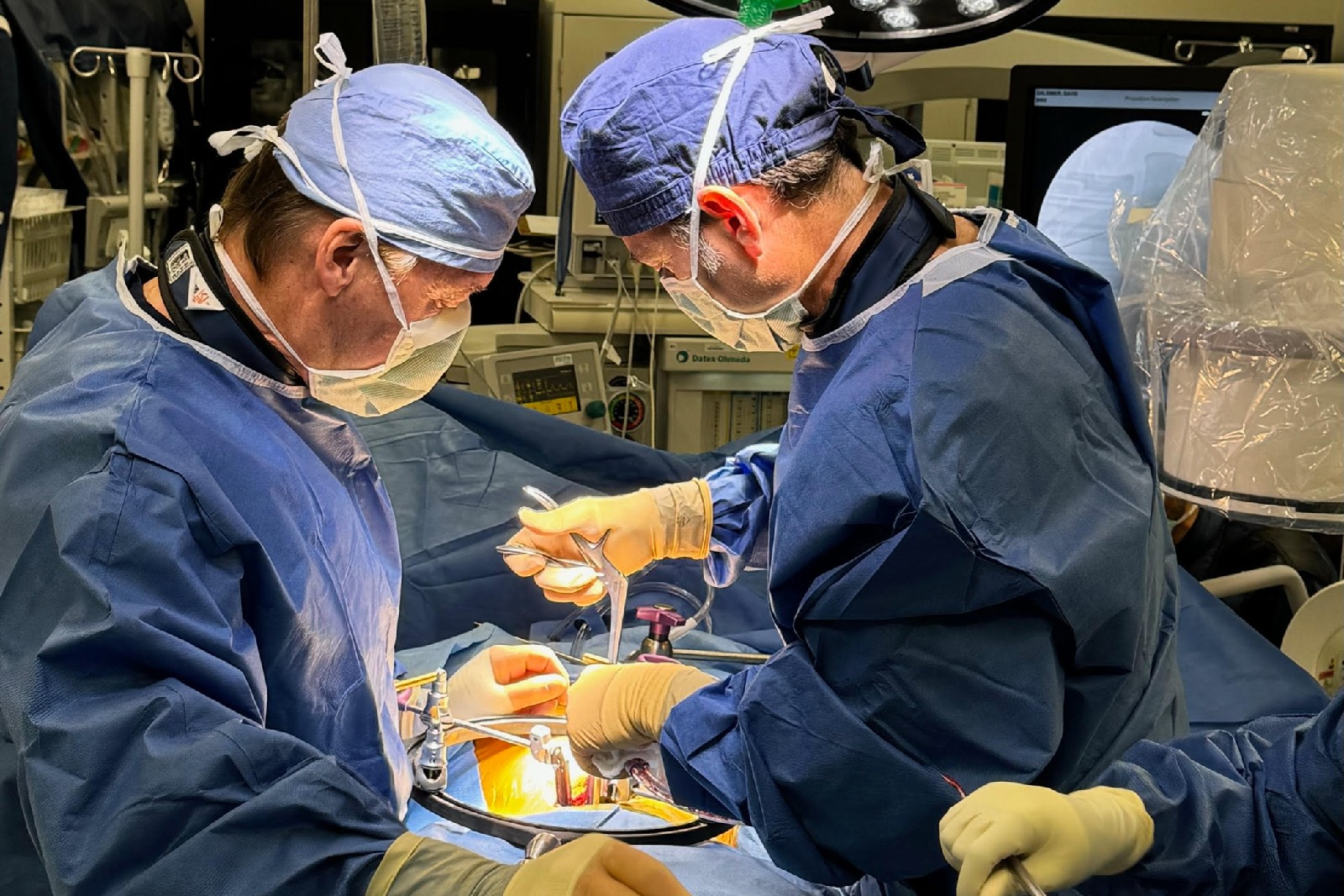Cervical Radiculopathy Treatment – Alleviating Neck Pain and Restoring Comfort in Palm Beach County

Understanding Cervical Radiculopathy
Cervical Radiculopathy is a pinched or irritated nerve in the neck that causes pain, numbness, or weakness that then radiates out into the shoulders, arms and/or hands. Cervical Radiculopathy often resolves on its own, however for patients where that is not the case, this condition can create a constant radiating pain or weakness. This chronic pain can begin to have an effect on one’s day-to-day living. Dr. Cuellar is an expert in the field of spinal surgery with a special focus on helping patients with chronic pain conditions find relief. Dr. Cuellar specializes in recommending the least invasive procedures available for his patients.
Nerve compression syndrome is when pressure is put on a nerve in the peripheral nervous system. These nerves connect to parts of your body (like your hands and feet) that are farther away from the central nervous system (like your brain and spinal cord). Because these nerves are furthest away from the central nervous system, symptoms for cervical radiculopathy can feel like tingling, numbness, weakness or sharp pain in one’s extremities that starts in the neck.
The spinal vertebrae house the spinal cord and nerve roots as they exit and become spinal nerves. When something impacts or interferes with this system – be it an injury or damaged or diseased disc, or a tumor – this may cause pressure on the spinal nerve roots, which causes pain, numbness or weakness.
Recognizing Symptoms and Diagnosis
Cervical Radiculopathy can produce several symptoms, such as radiating pain down the arms, numbness and tingling sensations, muscle weakness and a loss of coordination of the hands.
Cervical Radiculopathy must be detected early with the aid of diagnostic imaging, such as MRI scans. Catching a spinal condition early is the key to finding a solution and path to a better quality of life. Furthermore, if a nerve root is chronically compressed it can cause permanent damage. Performing an MRI will help a surgeon to identify the root cause of the pain emanating out from your condition. MRI imaging will provide an in-depth look at the discs, spinal cord or nerve roots and help determine the source of nerve root compression.
Treating Cervical Radiculopathy
Nonsurgical Treatment Approaches
Cervical Radiculopathy can be treated by a number of non-surgical treatment options.
-
Limiting Activities: Your doctor may recommend that you limit your activities in order to reduce pressure on the nerves or even use a cervical collar in order to stabilize and support the neck.
-
Anti-Inflammatory Medication: There are also a number of nonsteroidal anti-inflammatory drugs (NSAIDs) available for treating Cervical Radiculopathy, such as:
-
Naproxen
-
Ibuprofen
-
Celebrex.
-
-
Physical Therapy: Your doctor may recommend that you treat your Cervical Radiculopathy with pain management medication alongside physical therapy, to help strengthen and improve your mobility.
-
Gentle Exercise: Cervical traction, and exercise in which you gently position and stretch your neck, may also play a positive role in your treatment plan against Cervical Radiculopathy.
Interventional Procedures for Relief
Cervical Radiculopathy is also treatable with interventional procedures that provide relief. Epidural steroid injections and nerve blocks have been proven to provide temporary relief in the affected area(s), by numbing the pain.
Surgical Options for Severe Cases
In instances of severe cases, there are surgical options available to treat Cervical Radiculopathy. This option should be seen as a last resort, when all previous conservative methods have been exhausted and failed.
-
Bone spurs, or a growth of bony material at the edge of a bone, often cause issues with nerve compression. Your doctor may recommend a surgical procedure to help relieve the pain caused by bone spurs or other contributing factors, such as material from a herniated disc or a bone spur that are in a nerve pathway.
-
Cervical radiculopathy is the best indication for artificial disc replacement (ADR) also known as total disc replacement (TDR) or total disc arthroplasty. Disc replacement is the most successful surgical procedure used to treat cervical radiculopathy when performed by an experienced spinal arthroplasty surgeon. Dr. Cuéllar specializes in spinal disc replacement surgery.
Nonsurgical vs. Surgical Approach
Cervical Radiculopathy is treatable through both non-surgical and surgical options and should be addressed quickly. If symptoms persist or worsen, you may wish to consider surgery as a long-term option. Cervical Radiculopathy is a condition that will often heal on its own. Surgical options should only be considered when all else has failed.
There are several intervention strategies for managing cervical radiculopathy, with physical therapy and surgical interventions being the most common to aid in long-term implications from this condition. For surgical options, patients will require assistance post-surgery and should not expect to return to their regular physical activities until after the 3-6 week recovery time has passed.
Expert Consultation and Customized Treatment Plans
Dr. Cuellar began his undergraduate studies at U.C Davis in Neurobiology, Physiology and Behavior, but went on to earn a Ph.D in Molecular, Cellular and Integrative Physiology due to experiencing his own pain from a herniated disc – Dr. Cuellar sought to understand how disc herniation causes pain at a molecular level. Dr. Cuellar went on to study at Stanford University Medical School and completed his training in orthopaedic surgery at the prestigious New York University-Hospital for Joint Disease. During that 6-year training period, Dr. Cuellar treated patients at the two busiest level-1 trauma centers in New York. He has since become a leader in treating chronic pain across the spinal surgeon industry. Furthermore, Dr. Cuellar stays abreast of the most cutting- edge technology available to further support the care he gives to each of his patients.
Seeking out the right diagnosis as soon as symptoms present themselves is the key to maintaining your spinal health. Cervical Radiculopathy is a treatable condition – Dr. Cuellar is here to guide and support his patients through the process, every step of the way.
Find the answers to your spinal health questions with Dr. Cuellar. We provide a full physical evaluation alongside an assessment of your medical history and design comprehensive curated treatment strategies to find the best solution to pain-free outcomes. Call us today to schedule a consultation and book an appointment with our staff at our office in Palm Beach County and Miami.
Frequently Asked Questions (FAQs)
- What Causes Cervical Radiculopathy?
Cervical Radiculopathy is most often caused by a disc herniation or bone spur compressing a nerve root. - Is Cervical Radiculopathy the same as Spinal Cord Compression?
Cervical Radiculopathy is the when the nerve root is compressed. This is different than when the spinal cord is compressed, although some symptoms may overlap. - What Are Bone Spurs and How Do They Contribute to Symptoms?
Bone spurs are an abnormal bone growth that place unwelcome pressure on the nerve root or the spinal cord. This pressure can cause nerve root irritation or compression, leading to pain, numbness or tingling. - When is Surgical Treatment Necessary for Cervical Radiculopathy?
Cervical Radiculopathy can require surgical treatment if symptoms worsen or do not go away on their own. Ask your doctor what the best treatment for cervical radiculopathy is for you. -
What is the most effective treatment for cervical radiculopathy?
The most effective treatment for cervical radiculopathy varies depending on factors such as symptom severity and individual patient characteristics. Conservative approaches like physical therapy and medication are often recommended initially. If these methods fail to provide relief, minimally invasive procedures or surgery may be considered, especially in severe cases. - How should I sleep with cervical radiculopathy?
When sleeping with cervical radiculopathy, it’s recommended to sleep on your back or side with proper neck support. Using a cervical pillow or placing a rolled towel under your neck can help maintain spinal alignment. Avoid sleeping on your stomach as it can strain the neck and worsen symptoms. - What happens if cervical radiculopathy is left untreated?
If left untreated, cervical radiculopathy can lead to worsening symptoms and potential complications. Chronic nerve compression may result in permanent damage, causing persistent pain, weakness, and loss of function in the affected areas. Early detection and treatment are crucial to prevent long-term consequences. - Does cervical radiculopathy ever go away?
Cervical radiculopathy can resolve on its own in some cases, particularly if the underlying cause is minor and temporary. However, the likelihood of spontaneous resolution varies among individuals and depends on factors such as the severity of nerve compression. Seeking medical evaluation and following recommended treatment options increase the chances of symptom improvement and recovery. - What can you not do with cervical radiculopathy?
While living with cervical radiculopathy, it’s important to avoid activities that may exacerbate symptoms or strain the neck and spine. Activities involving repetitive neck movements, heavy lifting, or high-impact sports should be approached with caution to prevent worsening of symptoms and potential complications. - Is heat good for cervical radiculopathy?
Heat therapy can provide temporary relief for cervical radiculopathy by increasing blood flow and relaxing tense muscles in the neck and shoulders. Applying a warm compress or taking a warm shower can help alleviate pain and stiffness. However, heat should be used cautiously as excessive heat can exacerbate inflammation in some individuals. Consulting with a healthcare professional for personalized recommendations is advisable. - What aggravates cervical radiculopathy?
Several factors can aggravate cervical radiculopathy and worsen symptoms. Poor posture, repetitive neck movements, and activities that strain the neck should be avoided. Additionally, sudden neck movements or jolts, such as contact sports or amusement park rides, can trigger symptoms and should be approached with caution.
More News & Insights from Cuéllar Spine
Exploring the Success Rates and Benefits of Laminectomy Without Fusion Surgery
Lumbar disc replacement surgery offers a promising alternative to traditional treatments for debilitating back pain and limited mobilit
The State of Outpatient Spine Surgery in 4 Studies
Outpatient spine surgery is growing, and its outlook suggests the trend will likely continue. Here are four studies illustrating the st
The Pros and Cons of Lumbar Disc Replacement (Also known as Total Disc Replacement (TDR), Total Disc Arthroplasty (TDA), or Artificial Disc Replacement (ADR))
Lumbar disc replacement surgery offers a promising alternative to traditional treatments for debilitating back pain and limited mobilit
10 Signs You May Need Revision Spine Surgery
Revision spine surgery, also known as secondary spine surgery, plays a crucial role in addressing persistent or recurrent spinal condit
Lumbar Total Disk Replacement Device Removals and Revisions Performed During a 20-Year Experience with 2141 Patients
This was a retrospective study with prospective patient contact attempted to collect current data.
36-Year-Old Male with History of Neck Pain
36-Year-Old Male with History of Neck Pain Radiating Into Both Shoulders, Numbness in Radial 3 Fingers of Both Hands
Problems with Artificial Disc Replacement
Artificial disc replacement (ADR), also known as total disc replacement (TDR), has emerged as a revolutionary approach in the field of
Top 5 Ways a Spinal Surgeon Can Help with Neck Pain
It is easy to take the movement in our necks for granted - and yet, when we are in pain, our neck flexibility can become extremely limi
ADR Spine Announces the Inclusion of Four Surgeons to Its National Top Doctors in Arthroplasty Program
ADR Spine Welcomes Elite Physicians to Top Doctors in Arthroplasty Program










